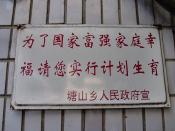As China realised the need for modernisation, the one child policy was implemented in June 1979 to achieve three main goals:
1. To address the low per capita GNP by increasing the per capita income to $800.
2. To increase or improve the standard of living.
3. To keep China's total population size from exceeding 1.2 billion by the year 2000.
China recognised the easiest way to achieve these goals was by restricting the population growth. That way, there would be a more likely increase in per capita income.
Although several attempts have been previously made to control fertility growth, it was little as effective as it was optional and not many complied. However, China's one child policy was a completely different matter. By accepting the policy, you were eligible for certain privileges and if you reject it, you'll have to pay a fine. These regulations helped enforce the one couple, one child idea.
The one child policy proved to be a great success in urban China but ineffective in rural China. Regardless of their educational attainment or residence, all women generally desired two children.
The one child policy worked best in urban China because of the strong organisation control and social transformations that changed the function of children and reduced the preference for sons. In an urban sample, in both Hebei and Shaanxi, the sex of the first child is insignificant. This lack of sex preference effect was the main ingredient for success of the one child policy.
However, this was not the case in rural China where villagers were in favour of traditional preferences for sons. Although the implementation of the one child policy caused a decline in rural fertility rate from about five to 2.4 children by making farmers realise they needed high quality labourers and not...



Great look into China
This was a great essay. I had lillte knownledge of the 1 couple 1 child act in china, therefore this essay provided me with enough information to make this topic a discussion in my social science class. Great essay!
4 out of 4 people found this comment useful.